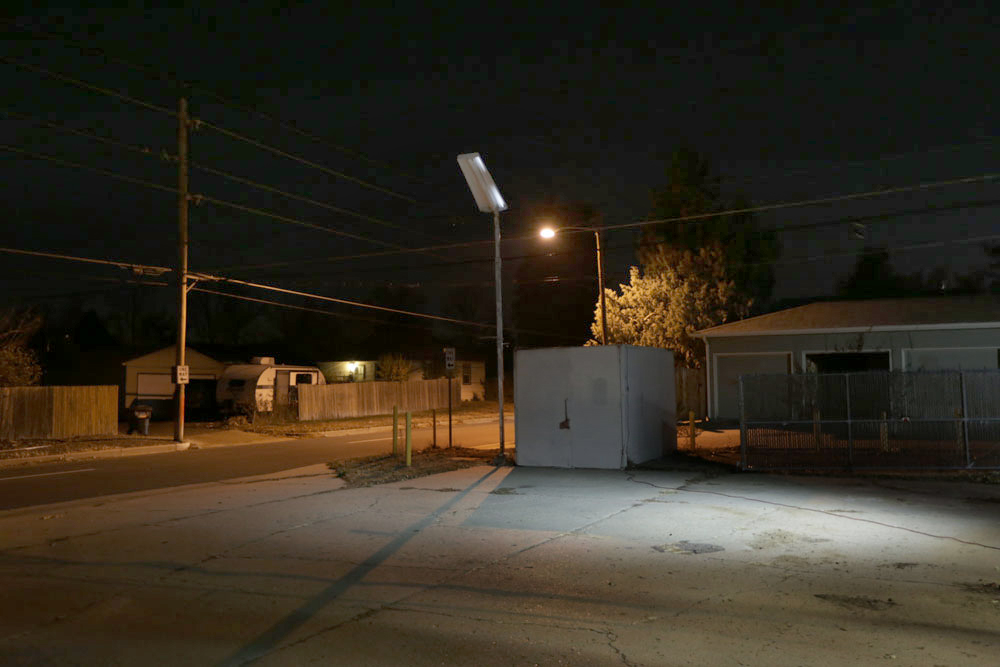

2018
Installation, Counterpath, Denver CO (US)
Excavation, flickering street lamp, black-flag curtain, discarded/found furniture sculptures, speakers, amp, mixer, audio sample, color print on canvas, video
With his exhibition Ghosts, Berlin-based, American artist Erik Smith focuses on the material traces of history and memory specific to the Counterpath site and surrounds of Denver’s East Colfax neighborhood, reconfiguring and collaging these to generate “new ambiances and new psychic possibilities” (Debord) for reconsidering the legacies of the area and its present-day meanings.
A temporary excavation of Counterpath’s outdoor lot exposing the former location of a buried oil tank, a long-defunct 1950s street lamp located in front of the building made to flicker at night, and a series of found/discarded furniture collected around the city, painted black, and embedded with speakers emitting the droning and crackling sounds of a flickering fluorescent light form the central sculptural and sonic components of the exhibition. In combination they establish a dichotomy between present and past, positive and void, inside and outside, gallery space and the lot surrounding the Counterpath building, a former auto repair shop built in 1954 and revamped as an exhibition and cultural venue in 2015.
The title, Ghosts, points not only to the partial reanimating of the site’s past identity but also to the many vacant and derelict commercial buildings of this portion of East Colfax Avenue, an area long associated with transience, drug addiction, and prostitution. Smith documented these structures and other abandoned homes while canvassing the area for materials and images, his form of “walking research,” creating a visual archive that reflects psychoanalyst and author Christopher Bollas’s assertion, in his essay on architecture and the unconscious, that “each city has its ghost towns.” These images are presented in the back room in the form of a video slideshow and paired with a dark ambient audio track created by Smith in his Berlin studio, adding a further layer of estrangement to a portrayal of the city at odds with the popular vision of economic boom times.
Themes of urban disaffection also resonate in another large-scale work installed inside the gallery: a series of black 3×5’ vinyl flags, sewn partially together to form a semi-contiguous whole, are presented as an abstract, non-functional domestic element spanning the main wall of the space. The black flags, a symbol rooted in anarchist movements of the nineteenth century, along with the void of the dig and the droning and crackling of the flickering light, allude not only to the precarious reality of neighborhoods, buildings, and domestic objects at the end of their use cycle but also the current political and social unease hanging over society at large. Ghosts are dead buildings as well as the death of ideals around community and a sense of shared destiny today.
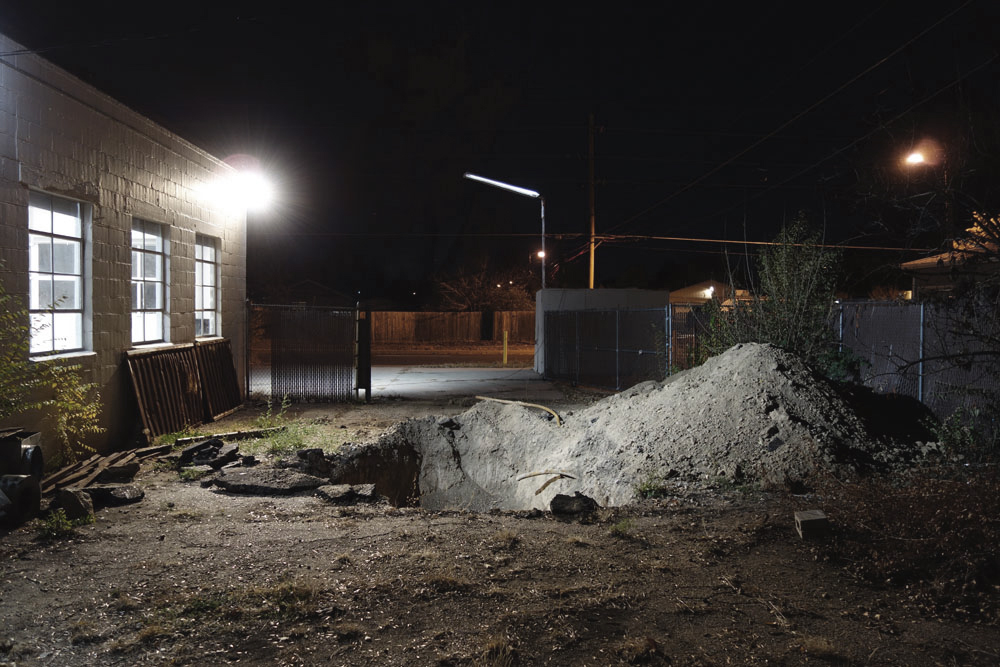
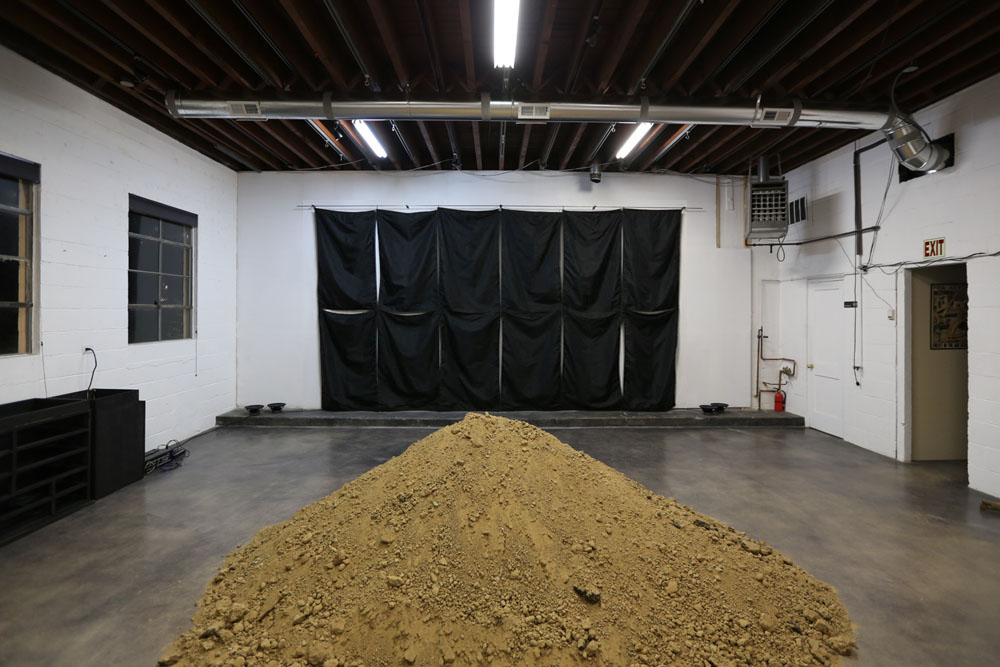
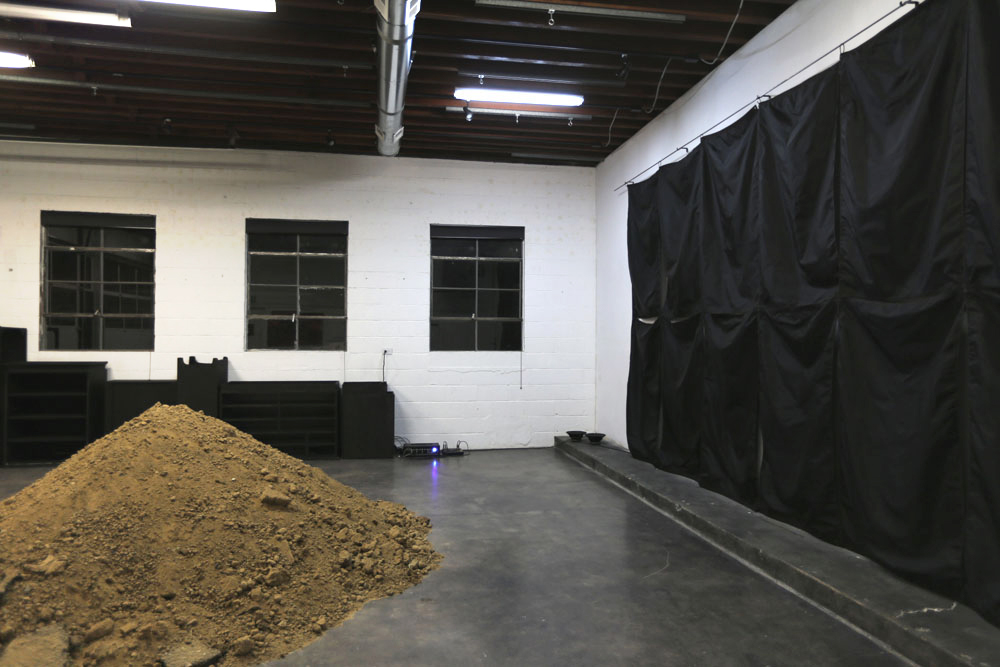
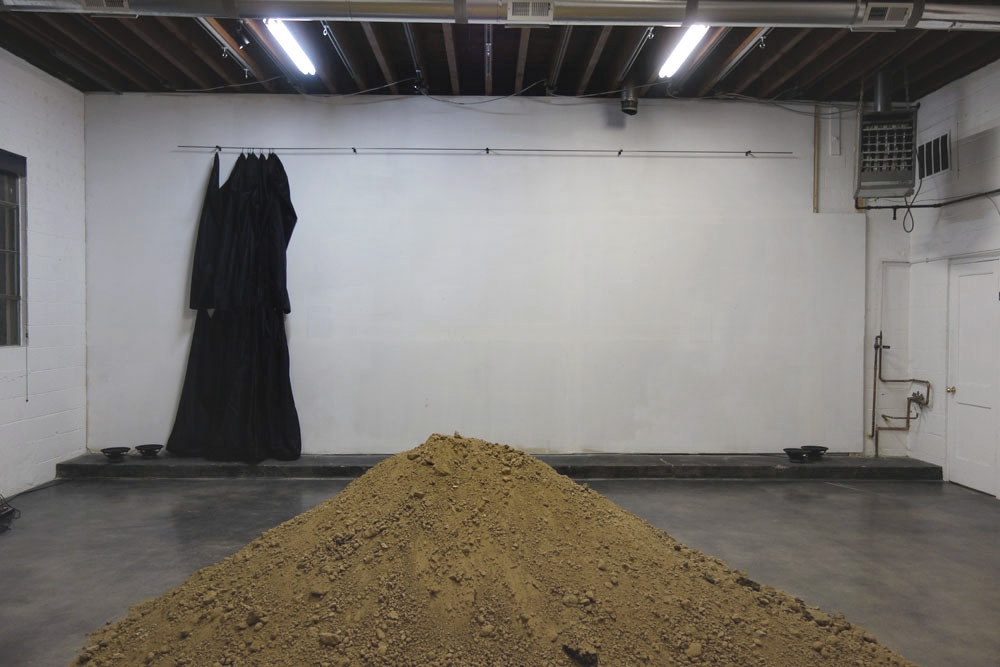
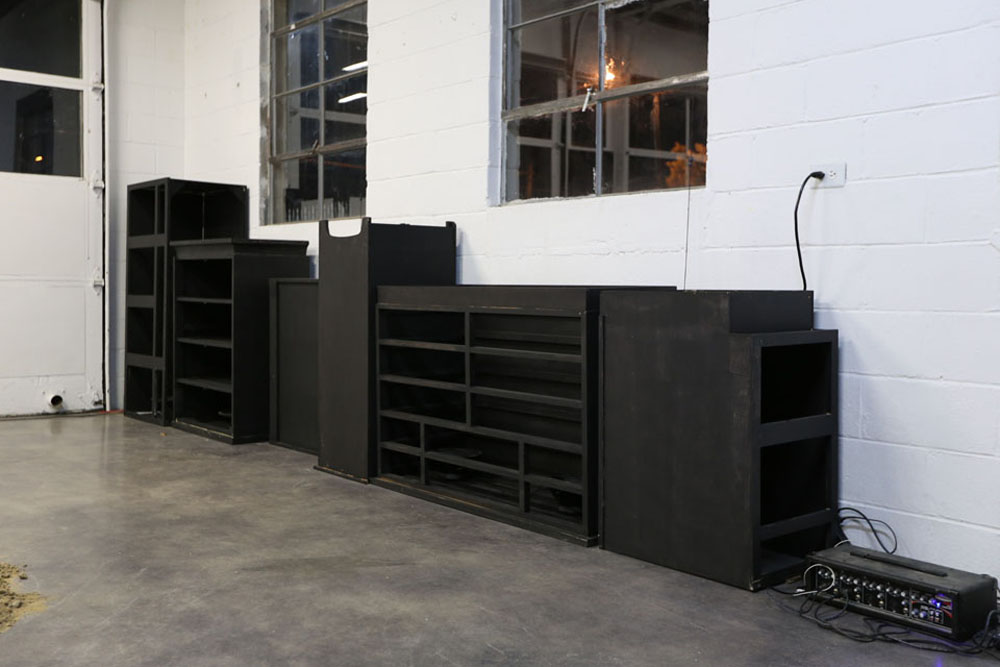
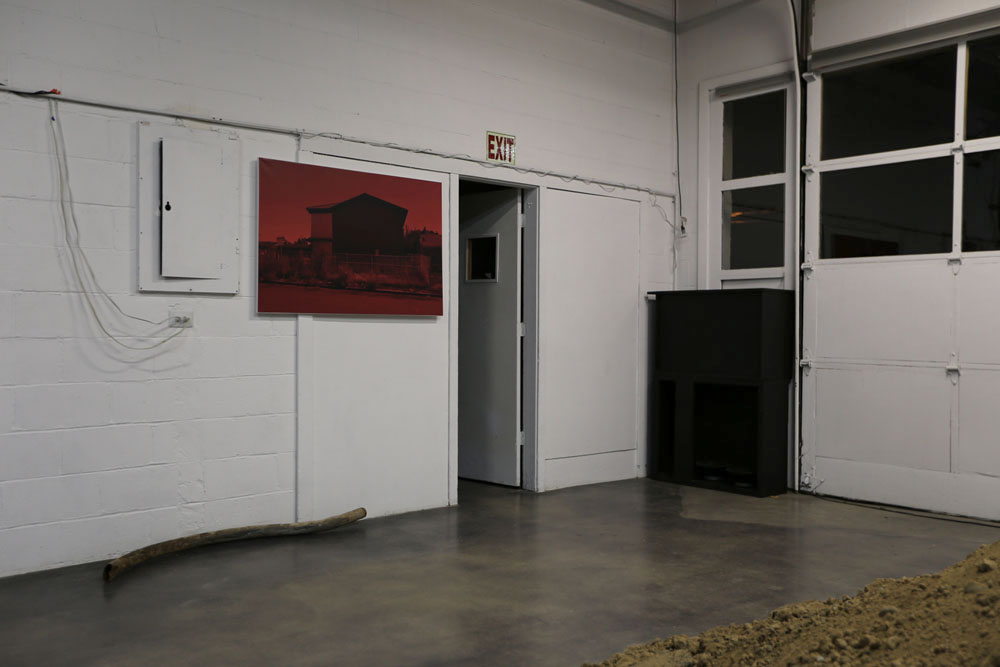
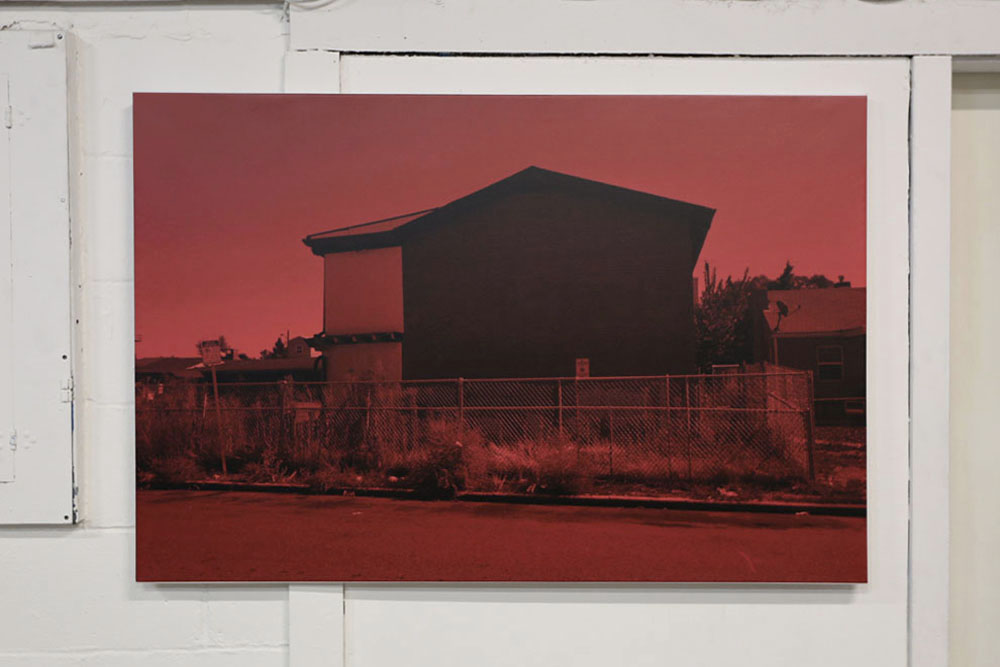
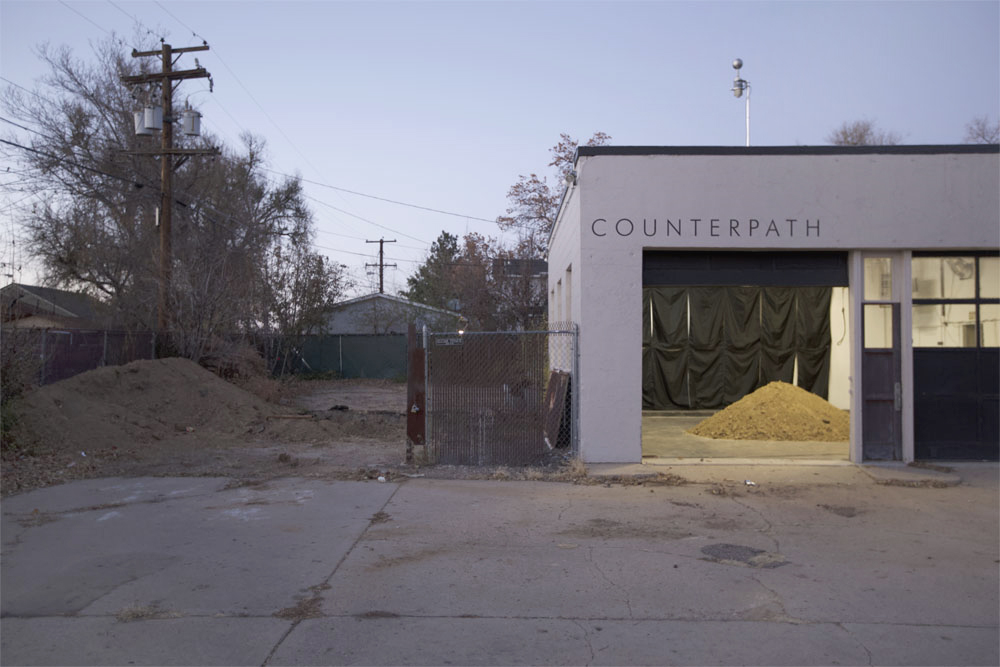
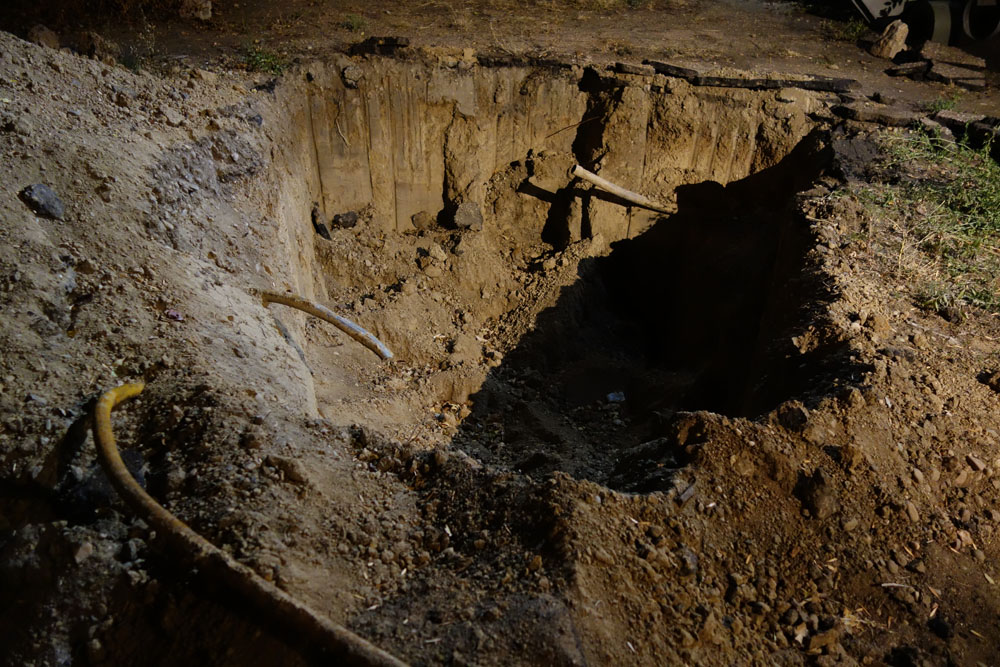
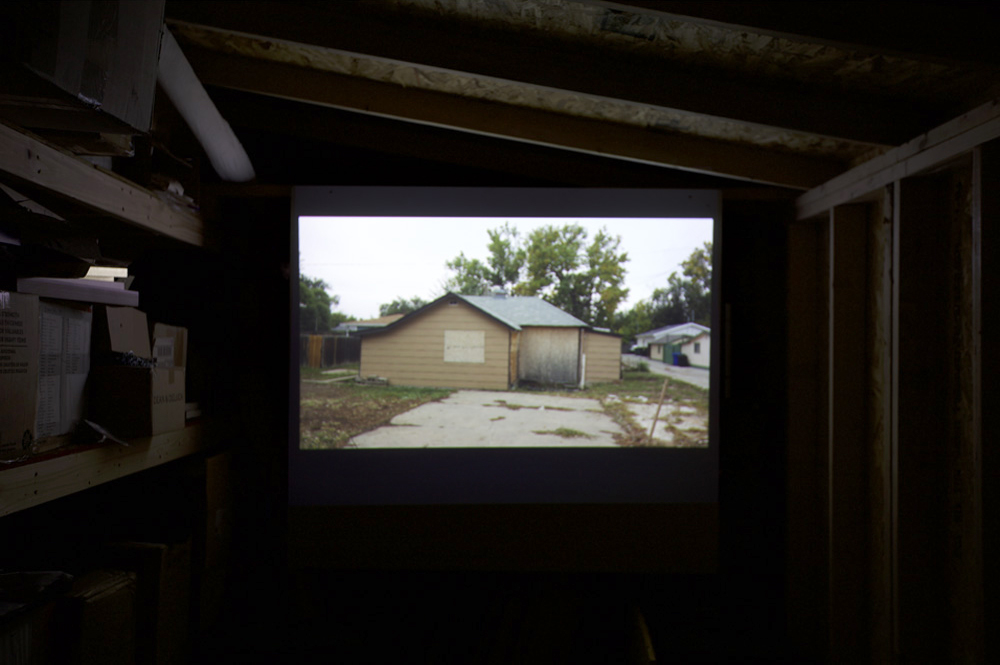
Tim Roberts: Can you describe what you are presenting at Counterpath?
Erik Smith: Ghosts operates as an orchestrated mix of intervention, objects, light/audio works, image and video. The works respond to the physical and historical context of the Counterpath building and surrounding East Colfax neighborhood by reanimating or reactivating aspects specific to the location, including a long-defunct street lamp that has been modified to flicker at night and the excavation of the area where an oil tank was once buried during the building’s previous incarnation as an auto repair shop. In combination, the works establish a relationship between the various sites that are the focus of the exhibition—inside/outside, present/past, building/neighborhood—creating an overall atmosphere that offers an impression of place that extends beyond immediate perceptions.
TR: Can you talk about what brought you to this particular conception of site and material? That is, how did you arrive at these notions of how context works?
ES: My thinking around site/context has evolved out of a way of approaching landscape that is primarily empirical in nature. Exploring places in person, on foot or bike, conducting excavations, salvaging objects, or documenting things photographically produces a first-hand understanding of site that brings into relief spatial, historical, cultural, or even political layers.
In the context of an exhibition, works are presented that seek to give form to these layers and their interdependencies by incorporating/referencing specific features but abstracting them as well. The idea is to create a hybrid new space of the familiar/unfamiliar whose juxtapositions and contrasts convey a feeling of place but also allude to what cannot be represented formally or in language, i.e. the hidden, buried, or unremembered narratives of a given location that operate on the margins of direct experience but nevertheless contribute to an overall atmosphere or vibe.
Found objects or excavations exposing previously concealed elements play an important role in this since they resonate a particular “stored-up” history that isn’t easily apparent; i.e. their form might point to a particular function or past but the actualities of how they existed in the world remain forever inaccessible. As anonymous, commonplace objects, their value as tangible relics is secondary to their importance as “meta-artifacts” or metaphors for excavating the immaterial memories of the site.
TR: Thanks and this kind of new empiricism seems both more and less grounded than what we might expect, refusing to get at anything except atmospherics at the same time that excavation performs an in-your-face immediacy of a pile of dirt. Before touching on other aspects of the show at Counterpath, I was wondering if you could say more about your personal trajectory as an artist. What was it like to grow up in the US, particularly Colorado, and then break camp for Berlin, where you have lived I think since 2003? What inspired the move and how did your practice evolve in and through being an "ex-pat"? Combined with this question is what the ambience must be of re-situating yourself back in the US right now, personally and politically?
ES: Well atmosphere can also be in-your-face, like Colfax Ave or the current political climate in the US, which are necessarily part of the exhibition context and also points of departure for the works presented. I see atmosphere not as a passive end in itself but as a means for getting viewers to look at or react—even on a subconscious level—to what constitutes their surroundings from a new perspective, but in a way that isn’t explicitly discursive. A critic and friend of mine in Berlin once described my work as “non-discursively discursive,” meaning that it gives physical form to issues that are otherwise manifested through discourse or language. The immediate and extended contexts of the exhibition play a role in this since many of my projects take place in and focus on transitional urban areas, where gentrification or other fundamental shifts are tearing at the social and historical identities of given locations. I approach these issues and contexts phenomenologically so what gets produced, be it a sculpture, audio sample, or a pile of dirt, resonates first and foremost on this perceptual, experiential level.
I left Colorado for San Francisco in the 1990s and SF for Berlin in 2003. SF was great pre-dot.com and was seminal to my development but I felt like I didn’t have a future there and wanted to turn things upside-down for myself as an artist. I had lived in Italy for two years during high school and college so the idea of returning to Europe was something that made sense to me. Berlin seemed like a work-in-progress then with a burgeoning international art scene so I made the move. For the first four years I felt like I was living in a state of "extended dislocation," slowly rebuilding myself linguistically and culturally, not feeling particularly German but also not really American in a conventional sense. Now the city has changed considerably, feels more and more like any other big city and, after fifteen years, routine. Part of its continued appeal for me however, apart from everything happening there art-wise, is the insider view I now have of another culture, and, in turn, an outsider view of my own. In a way I’ve become a hybrid of both perspectives: despite having a deeply internalized connection to Berlin as a city after so many years of living there, I still on some level feel a disconnect to German culture having come from outside; having grown up in the states I feel fundamentally American but, after so many years of being away, more and more disconnected to American culture and politics as well.
Living as an ex-pat is about negotiating these disconnections and gaps, and as an artist this has proven to be very fruitful ground. My interest around gaps, intermediary zones, transitional states gets translated into my site-based work, where areas in accelerated states of flux provide the opportunity to explore how such themes play out in the real world. Living in Berlin, where local history often intersects global history, got me thinking about the material nature of history, the capacity of physical matter to embody immaterialities, among them emotional states like (collective) trauma, and, conversely, of expressing immaterial quantities through physical form. Digging in Berlin, exposing otherwise concealed or forgotten elements of an earlier version of the city, was a way of bringing them back from the void, reanimating or re-materializing them, making them real. Applying this methodology in the US obviously produces different effects because of a difference in cultural and historical contexts. But working here, in particular Denver, is also intriguing to me because of my personal connection to the city, and how this connection has been fundamentally altered through my life abroad. Denver is both home and a foreign place simultaneously; the current political climate only intensifies this sense of estrangement for me, a feeling that home is no longer really home, but in this I’m not the only one.
TR: If ok I’d like to keep the atmospheric/immediate dichotomy in play and touch on some discrete aspects of the show at Counterpath. Can you give me a physical walkthrough of the space(s)? We’re of course discursively caught up in the prose of our interview here, and you’re welcome to, maybe I’m asking you to, depart from what holds that discursivity together, but I’m hoping to think about something we might agree on: that atmosphere can only exist in relation to what “presents” or displaces it (the pile of dirt? the negative space of the crater where the dirt was, which we’re asked to navigate?). Can you excavate what you thought your ideal audience member might do or be physically, maybe not at the “opening,” but maybe exactly then, since we had the Ghosts video (of marginal spaces in the East Colfax neighborhood) in the shed at that point. Is there a work or experience in relation to the show that particularly sets the stage for the other works? To put this in terms of an automated survey, what did you like, and what did you think could be better?
ES: Thinking about the entire Counterpath site and how to activate it spatially for viewers was central to conceiving the show. When I first visited in 2016 I was drawn to several features, including a dead, 1950s-era parking lot lamp located near the street and the section of lot on the west side of the building, which seemed like an ideal spot for conducting an excavation given its proximity to the gallery and former garage bay. While all the works in the exhibition are integral to the viewer’s experience and getting them to move through and around the site and to think about what’s happening both inside and outside, the flickering light probably sets the stage more than other works. It reappears in various parts of the show in a different form, as the droning and crackling audio sample heard inside the gallery emanating from various discarded/found furniture object-sculptures and in the random flashing-like presentation of images of marginal East Colfax spaces emerging out of the blackness in the video, which was presented in a storage shed in back of the building. Through the flickering, which implies a kind of imperfect state, a state of failure or disintegration, or a ghost-like trace of what was originally present, a relationship emerges between these different sites—inside/outside, present/past, building/neighborhood—and media.
The void of the excavation outside and the dirt pile inside serve to establish similar correspondences, and in the context of a gallery exhibition, the material rawness and immediacy of both relative to the other “finished” sculptural works have the potential to elicit a more visceral response in viewers. I agree with you that atmosphere exists in relation to what presents or displaces it; the effectiveness of displacement here is also about revealing something that would otherwise be hidden from view, the exposing of a buried past that confronts viewers. To varying degrees all works contribute to the multi-sensorial “atmosphere” that viewers are asked to negotiate as displaced things that point to their origins outside the enclosed framework of the gallery: the audio equivalent of the flickering street light seen outside, the found furniture objects lining the wall in a way that recalls how such discarded items are abandoned in back alleyways, or the black-flag curtain spanning the back wall of the space as an abstract embodiment of the current darkness / dysfunction hanging over society. Like the dirt mound and segment of broken pipe that reference the void of the crater outside, these act as disembodied presences that also tie the gallery space to what’s happening beyond its walls, in a collapsing or physical conflating of a traditional Smithson dichotomy of site / non-site.
http://counterpathpress.org/erik-smith-ghosts-opening-friday-november-2-6-9pm